Victor C. M. Leung
FedSM: Robust Semantics-Guided Feature Mixup for Bias Reduction in Federated Learning with Long-Tail Data
Oct 31, 2025Abstract:Federated Learning (FL) enables collaborative model training across decentralized clients without sharing private data. However, FL suffers from biased global models due to non-IID and long-tail data distributions. We propose \textbf{FedSM}, a novel client-centric framework that mitigates this bias through semantics-guided feature mixup and lightweight classifier retraining. FedSM uses a pretrained image-text-aligned model to compute category-level semantic relevance, guiding the category selection of local features to mix-up with global prototypes to generate class-consistent pseudo-features. These features correct classifier bias, especially when data are heavily skewed. To address the concern of potential domain shift between the pretrained model and the data, we propose probabilistic category selection, enhancing feature diversity to effectively mitigate biases. All computations are performed locally, requiring minimal server overhead. Extensive experiments on long-tail datasets with various imbalanced levels demonstrate that FedSM consistently outperforms state-of-the-art methods in accuracy, with high robustness to domain shift and computational efficiency.
A Survey on Cloud-Edge-Terminal Collaborative Intelligence in AIoT Networks
Aug 26, 2025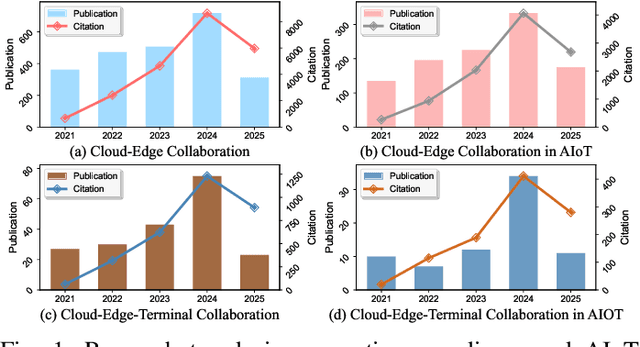
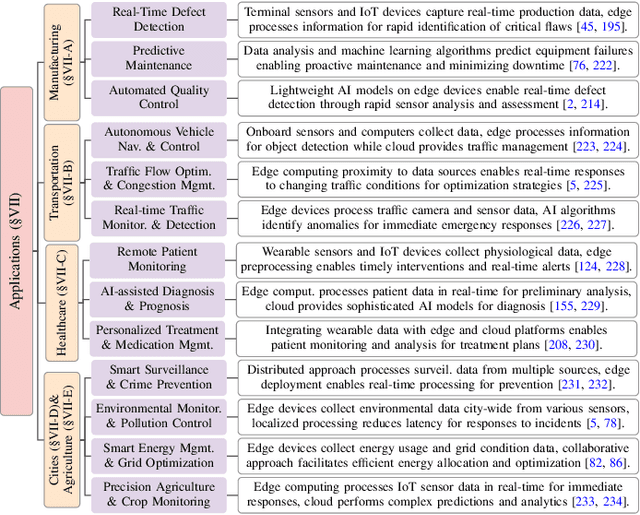
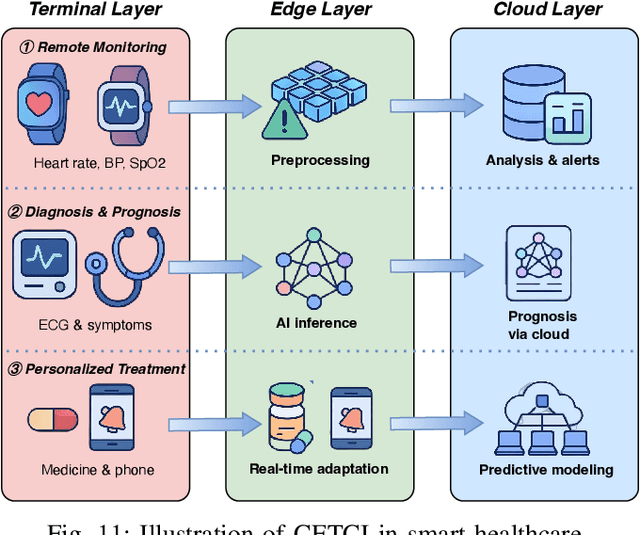
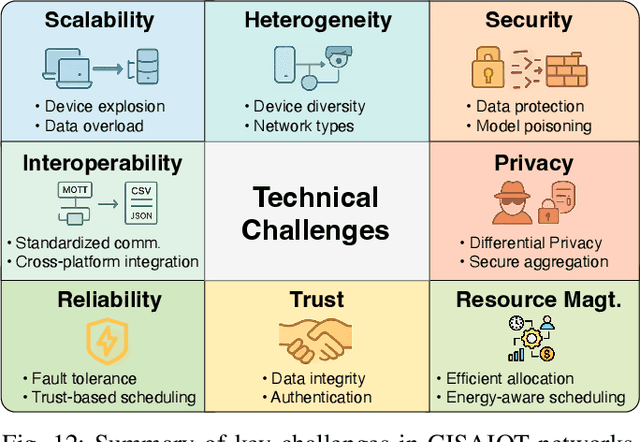
Abstract:The proliferation of Internet of things (IoT) devices in smart cities, transportation, healthcare, and industrial applications, coupled with the explosive growth of AI-driven services, has increased demands for efficient distributed computing architectures and networks, driving cloud-edge-terminal collaborative intelligence (CETCI) as a fundamental paradigm within the artificial intelligence of things (AIoT) community. With advancements in deep learning, large language models (LLMs), and edge computing, CETCI has made significant progress with emerging AIoT applications, moving beyond isolated layer optimization to deployable collaborative intelligence systems for AIoT (CISAIOT), a practical research focus in AI, distributed computing, and communications. This survey describes foundational architectures, enabling technologies, and scenarios of CETCI paradigms, offering a tutorial-style review for CISAIOT beginners. We systematically analyze architectural components spanning cloud, edge, and terminal layers, examining core technologies including network virtualization, container orchestration, and software-defined networking, while presenting categorizations of collaboration paradigms that cover task offloading, resource allocation, and optimization across heterogeneous infrastructures. Furthermore, we explain intelligent collaboration learning frameworks by reviewing advances in federated learning, distributed deep learning, edge-cloud model evolution, and reinforcement learning-based methods. Finally, we discuss challenges (e.g., scalability, heterogeneity, interoperability) and future trends (e.g., 6G+, agents, quantum computing, digital twin), highlighting how integration of distributed computing and communication can address open issues and guide development of robust, efficient, and secure collaborative AIoT systems.
Exploring Audio Cues for Enhanced Test-Time Video Model Adaptation
Jun 14, 2025Abstract:Test-time adaptation (TTA) aims to boost the generalization capability of a trained model by conducting self-/unsupervised learning during the testing phase. While most existing TTA methods for video primarily utilize visual supervisory signals, they often overlook the potential contribution of inherent audio data. To address this gap, we propose a novel approach that incorporates audio information into video TTA. Our method capitalizes on the rich semantic content of audio to generate audio-assisted pseudo-labels, a new concept in the context of video TTA. Specifically, we propose an audio-to-video label mapping method by first employing pre-trained audio models to classify audio signals extracted from videos and then mapping the audio-based predictions to video label spaces through large language models, thereby establishing a connection between the audio categories and video labels. To effectively leverage the generated pseudo-labels, we present a flexible adaptation cycle that determines the optimal number of adaptation iterations for each sample, based on changes in loss and consistency across different views. This enables a customized adaptation process for each sample. Experimental results on two widely used datasets (UCF101-C and Kinetics-Sounds-C), as well as on two newly constructed audio-video TTA datasets (AVE-C and AVMIT-C) with various corruption types, demonstrate the superiority of our approach. Our method consistently improves adaptation performance across different video classification models and represents a significant step forward in integrating audio information into video TTA. Code: https://github.com/keikeiqi/Audio-Assisted-TTA.
Model Splitting Enhanced Communication-Efficient Federated Learning for CSI Feedback
Jun 04, 2025Abstract:Recent advancements have introduced federated machine learning-based channel state information (CSI) compression before the user equipments (UEs) upload the downlink CSI to the base transceiver station (BTS). However, most existing algorithms impose a high communication overhead due to frequent parameter exchanges between UEs and BTS. In this work, we propose a model splitting approach with a shared model at the BTS and multiple local models at the UEs to reduce communication overhead. Moreover, we implant a pipeline module at the BTS to reduce training time. By limiting exchanges of boundary parameters during forward and backward passes, our algorithm can significantly reduce the exchanged parameters over the benchmarks during federated CSI feedback training.
Sentinel: Scheduling Live Streams with Proactive Anomaly Detection in Crowdsourced Cloud-Edge Platforms
May 29, 2025Abstract:With the rapid growth of live streaming services, Crowdsourced Cloud-edge service Platforms (CCPs) are playing an increasingly important role in meeting the increasing demand. Although stream scheduling plays a critical role in optimizing CCPs' revenue, most optimization strategies struggle to achieve practical results due to various anomalies in unstable CCPs. Additionally, the substantial scale of CCPs magnifies the difficulties of anomaly detection in time-sensitive scheduling. To tackle these challenges, this paper proposes Sentinel, a proactive anomaly detection-based scheduling framework. Sentinel models the scheduling process as a two-stage Pre-Post-Scheduling paradigm: in the pre-scheduling stage, Sentinel conducts anomaly detection and constructs a strategy pool; in the post-scheduling stage, upon request arrival, it triggers an appropriate scheduling based on a pre-generated strategy to implement the scheduling process. Extensive experiments on realistic datasets show that Sentinel significantly reduces anomaly frequency by 70%, improves revenue by 74%, and doubles the scheduling speed.
Edge-Cloud Collaborative Computing on Distributed Intelligence and Model Optimization: A Survey
May 03, 2025Abstract:Edge-cloud collaborative computing (ECCC) has emerged as a pivotal paradigm for addressing the computational demands of modern intelligent applications, integrating cloud resources with edge devices to enable efficient, low-latency processing. Recent advancements in AI, particularly deep learning and large language models (LLMs), have dramatically enhanced the capabilities of these distributed systems, yet introduce significant challenges in model deployment and resource management. In this survey, we comprehensive examine the intersection of distributed intelligence and model optimization within edge-cloud environments, providing a structured tutorial on fundamental architectures, enabling technologies, and emerging applications. Additionally, we systematically analyze model optimization approaches, including compression, adaptation, and neural architecture search, alongside AI-driven resource management strategies that balance performance, energy efficiency, and latency requirements. We further explore critical aspects of privacy protection and security enhancement within ECCC systems and examines practical deployments through diverse applications, spanning autonomous driving, healthcare, and industrial automation. Performance analysis and benchmarking techniques are also thoroughly explored to establish evaluation standards for these complex systems. Furthermore, the review identifies critical research directions including LLMs deployment, 6G integration, neuromorphic computing, and quantum computing, offering a roadmap for addressing persistent challenges in heterogeneity management, real-time processing, and scalability. By bridging theoretical advancements and practical deployments, this survey offers researchers and practitioners a holistic perspective on leveraging AI to optimize distributed computing environments, fostering innovation in next-generation intelligent systems.
CRCL: Causal Representation Consistency Learning for Anomaly Detection in Surveillance Videos
Mar 24, 2025Abstract:Video Anomaly Detection (VAD) remains a fundamental yet formidable task in the video understanding community, with promising applications in areas such as information forensics and public safety protection. Due to the rarity and diversity of anomalies, existing methods only use easily collected regular events to model the inherent normality of normal spatial-temporal patterns in an unsupervised manner. Previous studies have shown that existing unsupervised VAD models are incapable of label-independent data offsets (e.g., scene changes) in real-world scenarios and may fail to respond to light anomalies due to the overgeneralization of deep neural networks. Inspired by causality learning, we argue that there exist causal factors that can adequately generalize the prototypical patterns of regular events and present significant deviations when anomalous instances occur. In this regard, we propose Causal Representation Consistency Learning (CRCL) to implicitly mine potential scene-robust causal variable in unsupervised video normality learning. Specifically, building on the structural causal models, we propose scene-debiasing learning and causality-inspired normality learning to strip away entangled scene bias in deep representations and learn causal video normality, respectively. Extensive experiments on benchmarks validate the superiority of our method over conventional deep representation learning. Moreover, ablation studies and extension validation show that the CRCL can cope with label-independent biases in multi-scene settings and maintain stable performance with only limited training data available.
CLIP-Optimized Multimodal Image Enhancement via ISP-CNN Fusion for Coal Mine IoVT under Uneven Illumination
Feb 26, 2025Abstract:Clear monitoring images are crucial for the safe operation of coal mine Internet of Video Things (IoVT) systems. However, low illumination and uneven brightness in underground environments significantly degrade image quality, posing challenges for enhancement methods that often rely on difficult-to-obtain paired reference images. Additionally, there is a trade-off between enhancement performance and computational efficiency on edge devices within IoVT systems.To address these issues, we propose a multimodal image enhancement method tailored for coal mine IoVT, utilizing an ISP-CNN fusion architecture optimized for uneven illumination. This two-stage strategy combines global enhancement with detail optimization, effectively improving image quality, especially in poorly lit areas. A CLIP-based multimodal iterative optimization allows for unsupervised training of the enhancement algorithm. By integrating traditional image signal processing (ISP) with convolutional neural networks (CNN), our approach reduces computational complexity while maintaining high performance, making it suitable for real-time deployment on edge devices.Experimental results demonstrate that our method effectively mitigates uneven brightness and enhances key image quality metrics, with PSNR improvements of 2.9%-4.9%, SSIM by 4.3%-11.4%, and VIF by 4.9%-17.8% compared to seven state-of-the-art algorithms. Simulated coal mine monitoring scenarios validate our method's ability to balance performance and computational demands, facilitating real-time enhancement and supporting safer mining operations.
AoI-Sensitive Data Forwarding with Distributed Beamforming in UAV-Assisted IoT
Feb 13, 2025Abstract:This paper proposes a UAV-assisted forwarding system based on distributed beamforming to enhance age of information (AoI) in Internet of Things (IoT). Specifically, UAVs collect and relay data between sensor nodes (SNs) and the remote base station (BS). However, flight delays increase the AoI and degrade the network performance. To mitigate this, we adopt distributed beamforming to extend the communication range, reduce the flight frequency and ensure the continuous data relay and efficient energy utilization. Then, we formulate an optimization problem to minimize AoI and UAV energy consumption, by jointly optimizing the UAV trajectories and communication schedules. The problem is non-convex and with high dynamic, and thus we propose a deep reinforcement learning (DRL)-based algorithm to solve the problem, thereby enhancing the stability and accelerate convergence speed. Simulation results show that the proposed algorithm effectively addresses the problem and outperforms other benchmark algorithms.
Low-altitude Friendly-Jamming for Satellite-Maritime Communications via Generative AI-enabled Deep Reinforcement Learning
Jan 26, 2025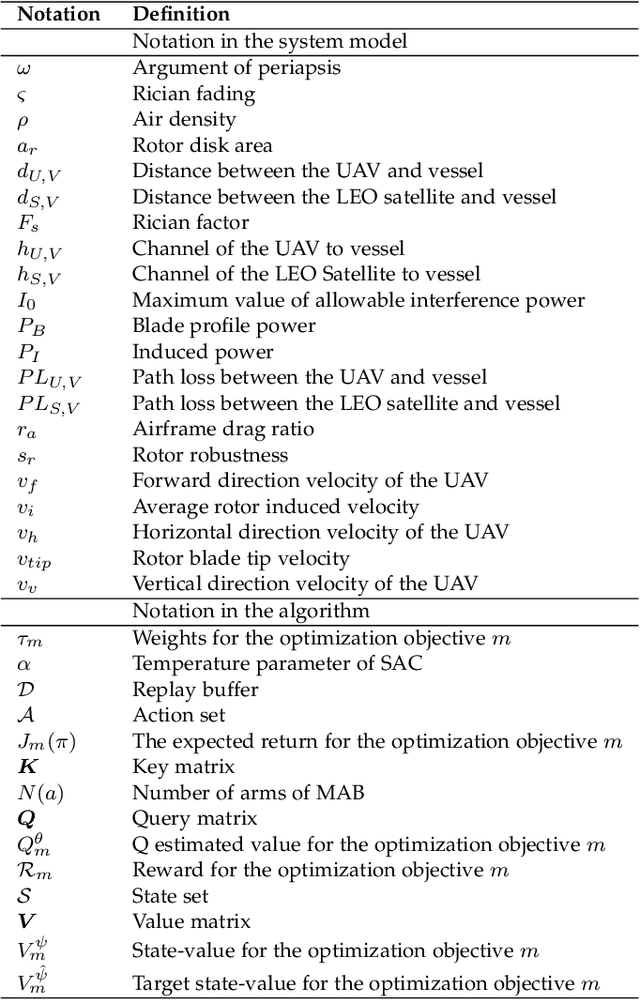
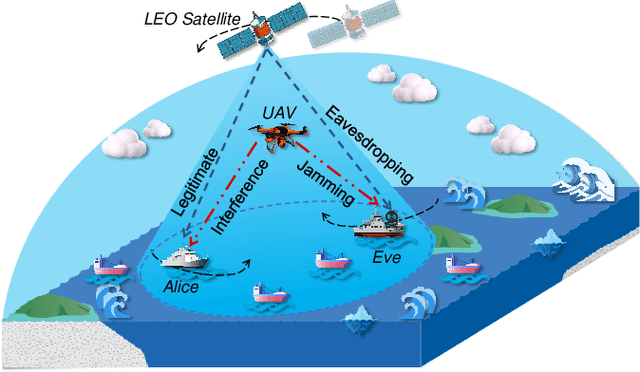

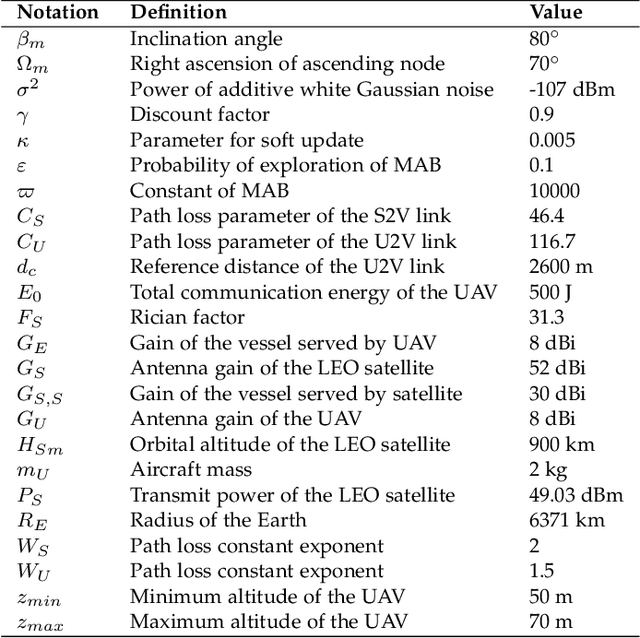
Abstract:Low Earth Orbit (LEO) satellites can be used to assist maritime wireless communications for data transmission across wide-ranging areas. However, extensive coverage of LEO satellites, combined with openness of channels, can cause the communication process to suffer from security risks. This paper presents a low-altitude friendly-jamming LEO satellite-maritime communication system enabled by a unmanned aerial vehicle (UAV) to ensure data security at the physical layer. Since such a system requires trade-off policies that balance the secrecy rate and energy consumption of the UAV to meet evolving scenario demands, we formulate a secure satellite-maritime communication multi-objective optimization problem (SSMCMOP). In order to solve the dynamic and long-term optimization problem, we reformulate it into a Markov decision process. We then propose a transformer-enhanced soft actor critic (TransSAC) algorithm, which is a generative artificial intelligence-enable deep reinforcement learning approach to solve the reformulated problem, so that capturing global dependencies and diversely exploring weights. Simulation results demonstrate that the TransSAC outperforms various baselines, and achieves an optimal secrecy rate while effectively minimizing the energy consumption of the UAV. Moreover, the results find more suitable constraint values for the system.
 Add to Chrome
Add to Chrome Add to Firefox
Add to Firefox Add to Edge
Add to Edge